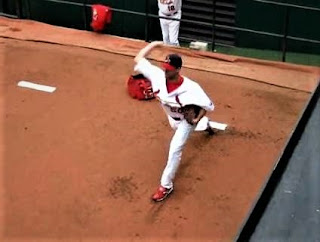Your "kinetic pitching chain's" origin.
Every kinetic chain revolves around your core.
Without an upright core, your body uses your arms and legs
to get your core back to vertical. On the other hand, when your core is in a vertical
position, you can freely use your arms and legs to move anyway you want.
People talk in general about “kinetic pitching chains”, but,
unknown to most, only “closed pitching chains” produce elite results.
How a “closed kinetic pitching chain” produces elite results?
The key to a "closed kinetic pitching chain" is getting your core into an upright position and opening your front shoulder before you end your stride.
Your upright core lets you open your front shoulder. Your
front shoulder action creates a separation between your hips and shoulders and,
ultimately, forces you to stride. When your front foot gets back on the ground,
you end up with your back hip ahead of your back shoulder. To get your
shoulders and hips over one another you make a throwing action.
In a "closed
kinetic pitching chain", no outside influence can impact your throwing
action. Once you open your front shoulder, your throwing action becomes an
involuntary reflex that regularly delivers 2 or more pitches in a row directly
into your Catcher’s target with late ball movement and maximum throwing arm
speed.
How an “open kinetic pitching chain” compromises your results?
When you begin your delivery with your feet too far apart or you place all your weight over your back foot, your naturally tilted core creates an "open kinetic pitching chain".
Before you can make any conscious movements, you must move
your core into an upright position. You do this by moving down the mound,
landing your foot plant and finally letting your body get your core back to
upright.
As a secondary action and influenced by your body position
at foot plant, you rotate your shoulders around your vertical core, struggle to
deliver 2 consecutive pitches into your Catcher’s mitt and frantically search
for ways to display better command.
Elite results are simple.
Keeping your core upright prior to your foot plant requires
a couple of simple adjustments. If you can’t find anyone to teach you how to
produce a “closed pitching chain”, contact me to find out how it’s done.
Skip Fast
Pitch Location Expert
Professional Pitching Institute
Professional Pitching Institute
E-Mail: skip@propitchinginstitute.com
Cell or Text: 856-524-3248
Cell or Text: 856-524-3248
Copyright © 2018







